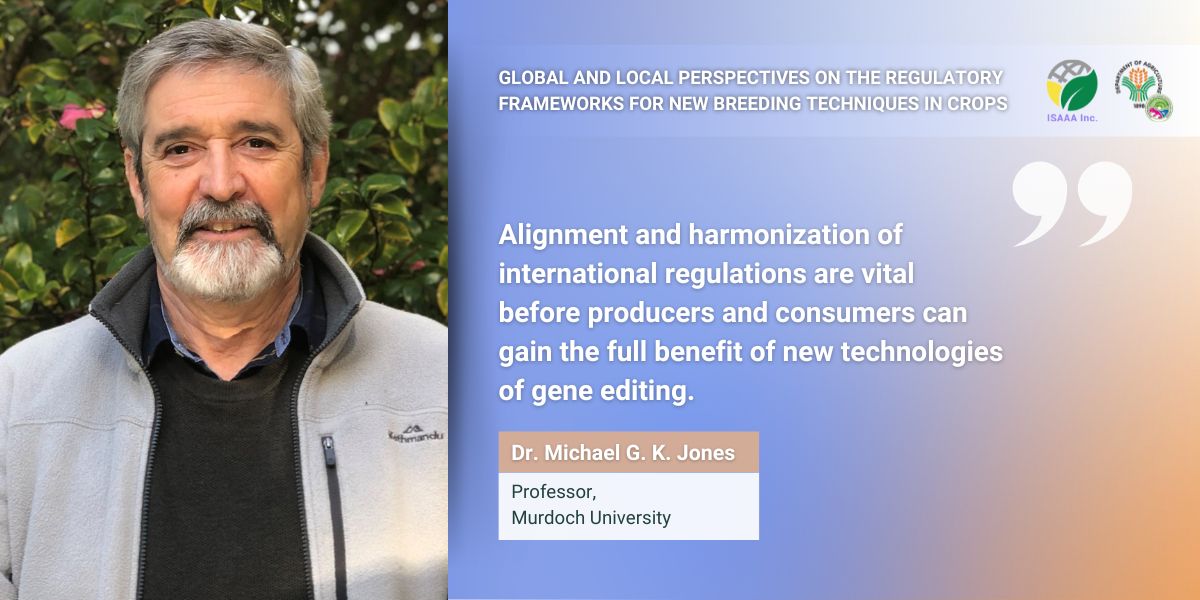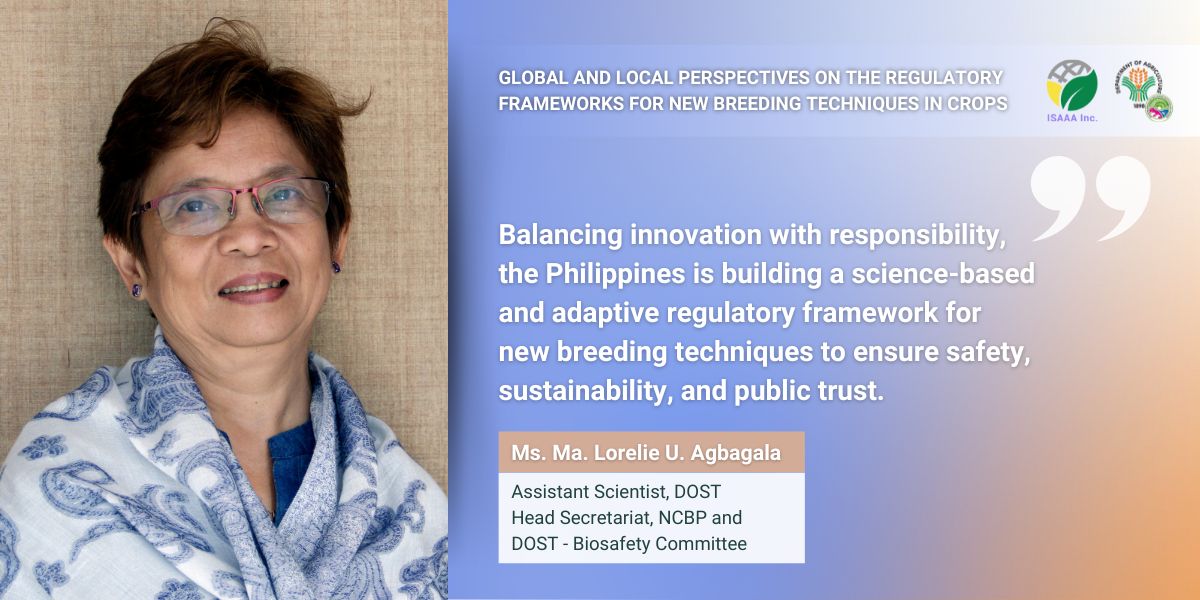How Are Crops Developed Through New Breeding Techniques Being Regulated?
| |
Plant breeding using modern biotechnology provides a faster and more precise way to breed plants compared to conventional plant breeding techniques. These techniques offer alternative solutions to addressing global challenges, such as food security, climate change, and sustainability. Countries around the world have taken different approaches to regulating crops developed through new breeding techniques (NBTs), with some treating them like conventionally bred plants and others applying stricter rules similar to genetically modified organisms (GMOs). As these innovations reshape agriculture, a crucial question comes into play: How are these crops being regulated?
Ms. Ma. Lorelie U. Agbagala, Assistant Scientist at the Department of Science and Technology (DOST) and Head Secretariat of the National Committee on Biosafety of the Philippines (NCBP) and DOST - Biosafety Committee, defined NBTs as plant breeding innovations (PBIs) that contain a new set of molecular, genomics, and cellular tools that enable the targeted and efficient development of new varieties of crops with desired traits or characteristics.
Dr. Michael G. K. Jones, a Professor from Murdoch University and the lead author of Enabling Trade in Gene-Edited Produce in Asia and Australasia: The Developing Regulatory Landscape and Future Perspectives, said that NBTs encompass a variety of methods that modify the DNA of plants to introduce desired traits. Defining GMOs and gene-edited products is important because of the differences in the regulations. Over time, the term NBTs has become more restricted to techniques of gene (or genome) editing that may or may not result in GMOs.
Overview of NBT Regulations in the Global Context
Dr. Jones explained the pathways to deregulation of gene-edited products in Australia, Japan, India, and China. In Australia, crops modified using SDN-1 (where genetic material is introduced without using a transgene) will not be subjected to regulation as GMOs and will be treated as conventionally bred crops. Dr. Jones said that Japan has the simplest advanced regulations. In Japan, a crop will not be subjected to GMO regulation if no externally processed nucleic acid is inserted and there is no nucleic acid in the final product.
In India, if the nature of editing falls under SDN-1 and SDN-2, the crop will be treated as a conventionally-bred plant, given that the modifications do not involve the use of exogenous DNA and the final product is free from exogenous DNA. In China, if no externally processed nucleic acid has been inserted, then the crop is not subjected to regulation as a GMO. However, crops subjected and not subjected to regulation as GMOs will still go through safety evaluation, crop variety registration, seed production evaluation, seed business evaluation, and processing evaluation before commercial planting.
In the Americas, countries with regulations for approving the growth of gene-edited plants include the United States and Canada in North America, as well as Argentina, Brazil, Chile, Paraguay, Uruguay, Colombia, Honduras, and Guatemala in South America. In Africa, regulations for gene-edited plants are either in place or being developed in Nigeria, Ghana, Kenya, Malawi, Uganda, Zimbabwe, Ethiopia, Mozambique, Botswana, and South Africa.
The trade of gene-edited produce is now possible in the USA and Canada, while countries in Latin America (Argentina, Brazil, Chile, Paraguay, and Uruguay) have their gene editing trade agreements. Currently, gene-edited produce in the EU is regulated as GMOs, and England has liberal gene editing regulations, excluding Wales, Scotland, and Northern Ireland. Trade in gene-edited produce is starting between Japan, the Philippines, and Thailand, while some countries in Africa are in the process of establishing gene editing policies.
“Alignment and harmonization of international regulations are vital before producers and consumers can gain the full benefit of new technologies of gene editing,” Dr. Jones said. With the current global status of gene-editing regulations, understanding the policies and regulations of these countries will unlock the potential of NBTs to develop more nutritious, sustainable, and environmentally friendly crops.

NBT Regulations in the Philippines
The NBCP Resolution No. 1 indicates that PBI products may be classified either as GMO or non-GMO based on the presence of a novel combination of genetic material obtained using modern biotechnology. In the Resolution, only PBI-derived GM plants will be regulated under the DOST-DA-DENR-DOH-DILG Joint Department Circular (JDC) No. 1, s2021. In 2022, the Department of Agriculture Memorandum Circular No. 8 was issued to provide the procedure for the determination of products of PBIs. Ms. Agbagala said that this guideline provides a systematic way to assess whether the PBI will result in a product that will qualify as GMO or fall outside the definition.
According to Ms. Agbagala, the Bureau of Plant Industry (BPI) Biotechnology Core Team - Plant Breeding Innovation (BCT-PBI) will form a Technical Consultation for Evaluation and Determination (TCED) Group to evaluate the PBI product and determine whether the final product contains a novel combination of genetic material. If determined as GMO, the PBI product will be subjected to JDC No. 1 s2021. Otherwise, the product developer will be issued a Certificate of Non-Coverage from JDC No. 1 s2021 for the non-GM PBI product. The Certificate of Non-Coverage will be posted on the website of BPI.
“Looking at the global regulatory landscape for gene-edited crops, I think it is safe to say that the Philippines’ approach aligns with the regulatory trends in other countries and regions,” said Ms. Agbagala. For the country to advance NBTs, capacity-building programs are needed to train regulators, scientists, and farmers on NBT adoption, and educating stakeholders, farmers, and the public is also essential.
Currently, the Bureau of Animal Industry (BAI) is preparing the groundwork for gene editing in animals and the NCBP has already drafted the guidance document for GM/gene-edited fish in the Philippines. “We know that there are still some steps that we have to go through, like regulatory reviews, stakeholder consultations, and documentation, but things are moving in the right direction,” said Ms. Agbagala.

Global and Local Perspectives on the Regulatory Frameworks for New Breeding Techniques in Crops is a webinar organized by ISAAA Inc. in collaboration with the Philippine Agriculture and Fisheries Biotechnology Program of the Department of Agriculture (DA Biotech). The webinar was attended by 310 participants including regulators, regulatory system experts, policy experts, researchers, partner institutions, farmers/farmer groups, and the general public.
Watch the recorded webinar on the ISAAA Webinars page and YouTube. Subscribe to Biotech Updates to stay updated with ISAAA’s upcoming webinars.
| Newer Post | Archive | Older Post |
Science Speaks is ISAAA Inc.'s official blog. Weekly blog articles, authored by ISAAA writers, partners, and invited contributors, aim to help share, disseminate, and promote scientific knowledge and its vital role in achieving global agricultural sustainability and development. Your support to Science Speaks will help us achieve this goal. You can help us by donating as little as $10.

